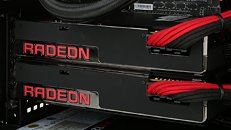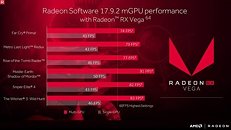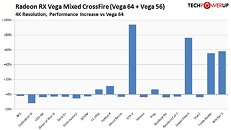Raevenlord
News Editor
- Joined
- Aug 12, 2016
- Messages
- 3,755 (1.18/day)
- Location
- Portugal
| System Name | The Ryzening |
|---|---|
| Processor | AMD Ryzen 9 5900X |
| Motherboard | MSI X570 MAG TOMAHAWK |
| Cooling | Lian Li Galahad 360mm AIO |
| Memory | 32 GB G.Skill Trident Z F4-3733 (4x 8 GB) |
| Video Card(s) | Gigabyte RTX 3070 Ti |
| Storage | Boot: Transcend MTE220S 2TB, Kintson A2000 1TB, Seagate Firewolf Pro 14 TB |
| Display(s) | Acer Nitro VG270UP (1440p 144 Hz IPS) |
| Case | Lian Li O11DX Dynamic White |
| Audio Device(s) | iFi Audio Zen DAC |
| Power Supply | Seasonic Focus+ 750 W |
| Mouse | Cooler Master Masterkeys Lite L |
| Keyboard | Cooler Master Masterkeys Lite L |
| Software | Windows 10 x64 |
An AMD representative recently answered PC World's query regarding the absence of "CrossFire" branding on their latest Radeon Software release, which introduced multi-GPU support for AMD's Vega line of graphics cards. According to the AMD representative, it goes down to a technicality, in that "CrossFire isn't mentioned because it technically refers to DX11 applications. In DirectX 12, we reference multi-GPU as applications must support mGPU, whereas AMD has to create the profiles for DX11. We've accordingly moved away from using the CrossFire tag for multi-GPU gaming."



The CrossFire branding has been an AMD staple for years now, even before it was even AMD - it was introduced to the market by ATI on 2005, as a way to market multiple Radeon GPUs being used in tandem. For years, this was seen as a semi-viable way for users to space out their investment in graphics card technology by putting in lesser amounts of money at a time - you'd buy a mid-range GPU now, then pair it with another one later to either update your performance capabilities to the latest games, or achieve the same performance levels as a more expensive, single-GPU solution. This has always been a little hit or miss with both vendors, due to a number of factors.
But now, the power to implement CrossFire or SLI isn't solely on the GPU vendor's (AMD and NVIDIA) hands. With the advent of DX 12 and explicit multi-adapter, it's now up to the game developers to explicitly support mGPU technologies, which could even allow for different graphics cards from different manufacturers to work in tandem. History has proven this to be more of a pipe-dream than anything, however. AMD phasing out the CrossFire branding is a result of the times, particular times nowadays where the full responsibility of making sure multi-GPU solutions work shouldn't be placed at AMD or NVIDIA's feet - at least on DX 12 titles.
View at TechPowerUp Main Site



The CrossFire branding has been an AMD staple for years now, even before it was even AMD - it was introduced to the market by ATI on 2005, as a way to market multiple Radeon GPUs being used in tandem. For years, this was seen as a semi-viable way for users to space out their investment in graphics card technology by putting in lesser amounts of money at a time - you'd buy a mid-range GPU now, then pair it with another one later to either update your performance capabilities to the latest games, or achieve the same performance levels as a more expensive, single-GPU solution. This has always been a little hit or miss with both vendors, due to a number of factors.
But now, the power to implement CrossFire or SLI isn't solely on the GPU vendor's (AMD and NVIDIA) hands. With the advent of DX 12 and explicit multi-adapter, it's now up to the game developers to explicitly support mGPU technologies, which could even allow for different graphics cards from different manufacturers to work in tandem. History has proven this to be more of a pipe-dream than anything, however. AMD phasing out the CrossFire branding is a result of the times, particular times nowadays where the full responsibility of making sure multi-GPU solutions work shouldn't be placed at AMD or NVIDIA's feet - at least on DX 12 titles.
View at TechPowerUp Main Site





